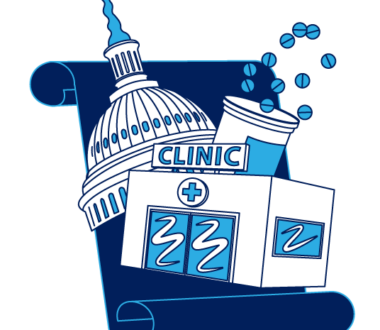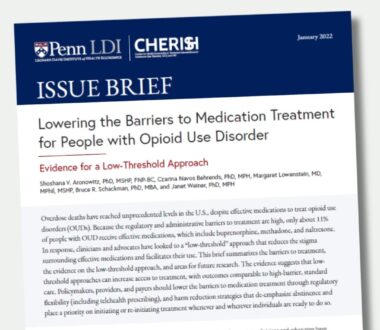
Will States and Counties Spend Their National Opioid Settlements Effectively?
As $54 billion in National Opioid Settlement funds begin moving out toward states, counties, and municipalities, there is widespread concern among health authorities that the legal victory does not become a repeat of the 1998 mega-billion-dollar Tobacco Master Settlement Agreement fiasco in which most states used the money for just about everything except tobacco cessation […]

New Federal Rules That Lower Barriers to Opioid Care Could Save Thousands of Lives
The two main medications that treat opioid use in the United States reduce overdose deaths by 50%. Yet fewer than one in 10 people with opioid use disorder (OUD) can access this kind of medical protocol, according to the Centers for Disease Control and Prevention (CDC). Fortunately, a new law and a new federal regulation […]

Budget Impact Tool for the Incorporation of Medications for Opioid Use Disorder into Jail/Prison Facilities
Despite evidence that medications for opioid use disorder (MOUD), namely methadone, buprenorphine, and naltrexone, provided at the point of incarceration improve the well-being of the individual and the public, financial and administrative limitations in jail/prison healthcare often serve as barriers to this recommended first-line treatment for OUD. In fact, evidence indicates that more than 80% […]

Catching Up with Pilot Grant Recipient: Rachel Epstein
Rachel Epstein is a clinician-scientist with demonstrated experience in analyzing large datasets to inform hepatitis C (HCV), HIV, and substance use disorder interventions. A CHERISH pilot grantee in 2019, she worked closely with her co-investigators Benjamin Linas, CHERISH Population Data and Modeling Core director, and Shashi Kapadia, a CHERISH Research Affiliate and an infectious diseases physician at Weill […]

A Catch-Up on Promising Efforts to Mitigate the Opioid Crisis
For the last 20 years or so, the U.S. has seen a significant increase in opioid and drug overdoses overall. And while there was a slight leveling before the pandemic, “we’ve seen huge increases since COVID-19,” said Margaret Lowenstein, an LDI Senior Fellow, addiction medicine physician, and an Assistant Professor of Medicine at the Perelman School of […]

Engaging with People with Lived Experiences in OUD Modeling Research
Drug overdose deaths continue to rise in the United States and Canada, with the risks for greater opioid use sharply increasing in Mexico. As modelers, we know simulation modeling is a valuable tool that can inform policies and interventions to prevent overdose deaths and reduce related harms including drug overdose, HIV, and hepatitis C virus […]

Prevalence of HIV Preexposure Prophylaxis Prescribing Among Persons with Commercial Insurance and Likely Injection Drug Use
The United States has made important strides to reduce the incidence and negative outcomes of HIV, including increasing the availability of effective treatment and prevention in the form of pre-exposure prophylaxis (PrEP). While the incidence of new HIV infections fell significantly from 130,000 in 1985, progress has stalled at approximately 39,000 new infections per year […]

Cost-effectiveness of Extended-release Injectable Naltrexone among Incarcerated Persons with Opioid Use Disorder Before Release from Prison Versus After Release
Compared to the general population, individuals with opioid use disorder (OUD) who are involved with the criminal-legal system have a much higher risk of a fatal overdose after release from incarceration. Yet, stigma, costs, and preferences for non-narcotic treatments in criminal-legal settings have stalled the implementation of life-saving treatment within the criminal-legal system. Extended-release naltrexone […]

Intern Spotlight: Grace L. Edwards, Jessica Girard, Lyric Harris, and Antara Saha
The Center for Health Economics of Treatment Interventions for Substance Use Disorder, HCV, and HIV (CHERISH) is delighted to welcome four astounding interns this summer: Grace L. Edwards, Jessica Girard, Lyric Harris, and Antara Saha. Setting personal goals to pursue medical journalism, forensic psychiatry, nursing, and a doctoral degree in developmental psychopathology, they applied through […]

Providing Naloxone in the Emergency Department Can Save Lives
Overdose deaths continue to be a national tragedy. More than 800,000 Americans died from an overdose between 1999-2019, and the annual rate of overdoses has increased dramatically during the pandemic, according to the latest data from the Centers for Disease Control and Prevention. Roughly 7 in 10 current overdose deaths involve opioids, which means that […]

Why Does the Opioid Mortality Rate Continue to Rise?
From April 2020 through April 2021, there were 100,300 drug overdose deaths across the country according to the CDC — a 28.5% increase over the previous year. Some 75% of these were opioid-related overdoses that killed an average of nine users an hour around the clock throughout the year. Looking forward, the just-published Stanford-Lancet Commission on […]

Lowering the Barriers to Medication Treatment for People with Opioid Use Disorder
Overdose deaths have reached unprecedented levels in the U.S., despite effective medications to treat opioid use disorders (OUDs). Because the regulatory and administrative barriers to treatment are high, only about 11% of people with OUD receive effective medications, which include buprenorphine, methadone, and naltrexone. In response, clinicians and advocates have looked to a “low-threshold” approach […]
Engage with CHERISH
Submit a Consultation Request or Contact Us to learn more about how CHERISH can support your research or policy goals.